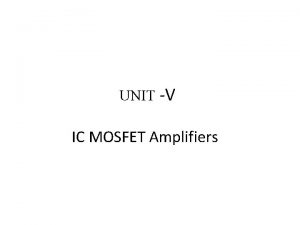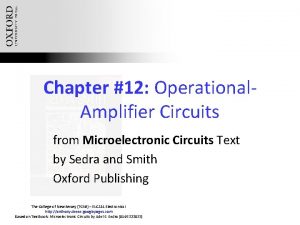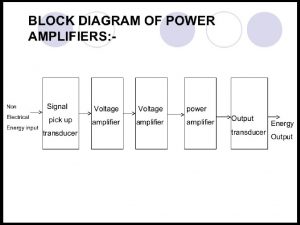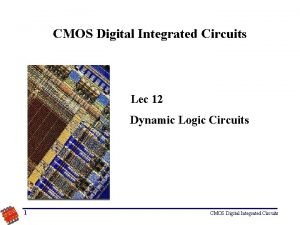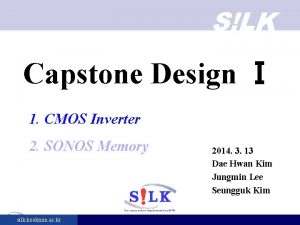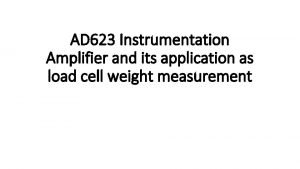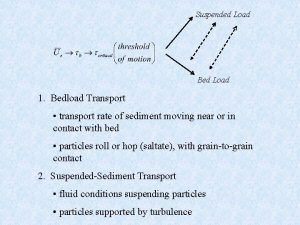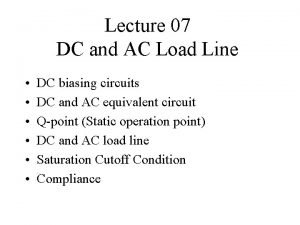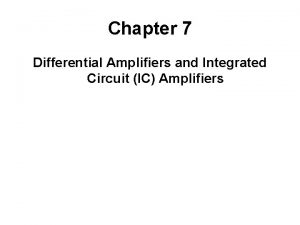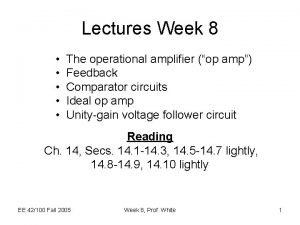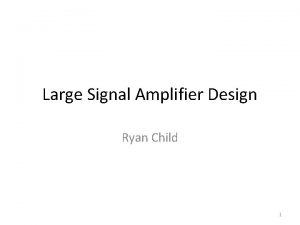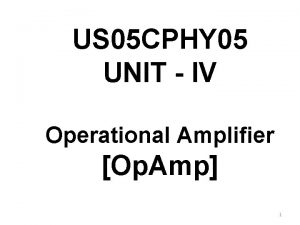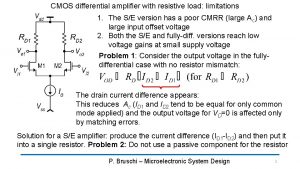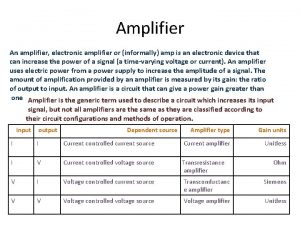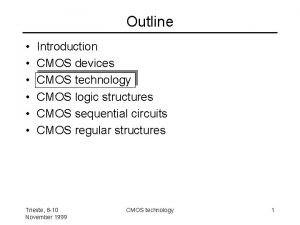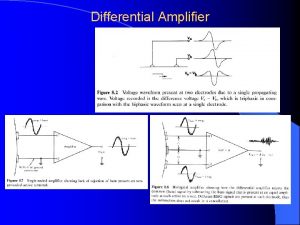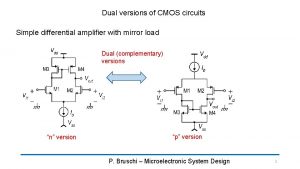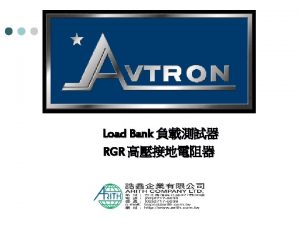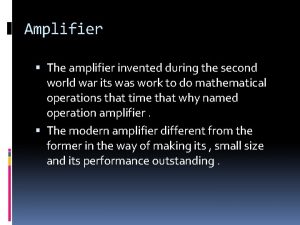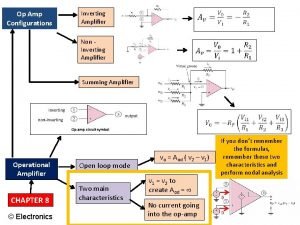CMOS differential amplifier with current mirror load Differential




























- Slides: 28

CMOS differential amplifier with current mirror load • Differential to S/E conversion • High CMRR (> 80 d. B) • High gain (~ 40 d. B) at low supply voltages (Vdd-Vss). High CMRR: we start from here: The low Ac shown for the fully-differential case is due • Small value of Id common mode variations • The output voltage is proportional to id 1 -id 2 P. Bruschi – Microelectronic System Design 1

CMOS differential amplifier with current mirror load ID 1+ID 2 ID 1 P. Bruschi – Microelectronic System Design 2

Operating point : Vid=0 Symmetrical stimulus, but …. The circuit is not symmetrical P. Bruschi – Microelectronic System Design 3

Demonstration of the exact symmetry of the electrical solution for Vid=0 M 1 and M 2 M 3 and M 4 P. Bruschi – Microelectronic System Design 4

Proof by contradiction (reductio ad absurdum) Contradiction P. Bruschi – Microelectronic System Design 5

Solution valid everytime Vd=0 K P. Bruschi – Microelectronic System Design 6

Differential mode gain P. Bruschi – Microelectronic System Design 7

P. Bruschi – Microelectronic System Design 8

Differential mode gain P. Bruschi – Microelectronic System Design 9

Differential mode gain In order to obtain a large differentialmode gain it is necessary to: • Set VTE to a small value • Use long mosfets (small l) In strong inversion. Minimum VTE=50 m. V P. Bruschi – Microelectronic System Design 10

Common mode gain vc vc Is it possible? ? P. Bruschi – Microelectronic System Design 11

Common mode gain The problem occurs when we calculate iocc. Placing a short circuit across the output port, disrupts the symmetry: vc vc P. Bruschi – Microelectronic System Design 12

Common mode gain It is possible to exactly calculate iocc, taking into accout the actual id 1/id 2 ratio and id 4/id 3 ratio …. vk vc … but this is a very tedious approach There is a much simpler way: vc Let us remove the short circuit and directly calculate vout. Now , for vid=0, the circuit is symmetric again and, in particular: vk=vout P. Bruschi – Microelectronic System Design 13

Common mode gain vk for Ros=rd (worst case) vc vc A CMRR of 80 d. B can be easily reached P. Bruschi – Microelectronic System Design 14

Large-signal dc transfer function In strong inversion P. Bruschi – Microelectronic System Design 15

Large-signal dc transfer function Vout variations for small VD variations around the origin gm 1 P. Bruschi – Microelectronic System Design 16

Moving away from the origin, step by step P. Bruschi – Microelectronic System Design 17

Large-signal dc transfer function P. Bruschi – Microelectronic System Design 18

Approximate dc transfer characteristic -VDMAX Example: Ad=100, Vdd-Vss=5 V VDMAX DVD<50 m. V P. Bruschi – Microelectronic System Design 19

Practically constant and equal to gm 1 M 4 enters triode region and rd 4 drops down M 2 enters triode region and rd 2 drops down P. Bruschi – Microelectronic System Design 20

Minimum output voltage VD in the linear zone is at most a few tens m. V VC varies between VSS and VDD P. Bruschi – Microelectronic System Design 21

Minimum output voltage Weak inversion Strong inversion P. Bruschi – Microelectronic System Design 22

Complete dc transfer characteristic P. Bruschi – Microelectronic System Design 23

Minimum Vdd-Vss |VDS 3| VDS 1 Vout. S Example: VMIN=100 m. V VDSAT 2=100 m. V |VGS 3|=0. 5 V P. Bruschi – Microelectronic System Design 24

Input common mode range Lower limit As VC is progressively decreased, also VS decreases at the same pace and eventually the voltage across the current source I 0 will get smaller than the minimum value VMIN. From that point on, I 0 will rapidly decrease, turning off the stage. P. Bruschi – Microelectronic System Design 25

Input common mode range Upper limit vk As VC is progressively increased, also VS increases at the same pace. Since Vout=VK =VD 2 = VD 1 is fixed, eventually VDS 1 and VDS 2 will drop below the saturation voltage. P. Bruschi – Microelectronic System Design 26

Input common mode range The input common mode voltage can get even slightly higher than Vdd P. Bruschi – Microelectronic System Design 27

P. Bruschi – Microelectronic System Design 28
 Common source amplifier with current mirror active load
Common source amplifier with current mirror active load Differential amplifier numericals
Differential amplifier numericals Differential and multistage amplifiers
Differential and multistage amplifiers Cmos amplifier
Cmos amplifier Power amplifier vs voltage amplifier
Power amplifier vs voltage amplifier Synchronous dynamic pass transistor circuits
Synchronous dynamic pass transistor circuits Nmos vtc
Nmos vtc Instrumentation amplifier applications
Instrumentation amplifier applications Nonsuperimposable
Nonsuperimposable Commonwealth fund mirror mirror
Commonwealth fund mirror mirror What is a mirror with a flat surface
What is a mirror with a flat surface Mehran convex mirror
Mehran convex mirror Convex mirror is a diverging mirror
Convex mirror is a diverging mirror Axial load and radial load
Axial load and radial load Bed load and suspended load transport
Bed load and suspended load transport Load paths
Load paths Difference between ac and dc load line
Difference between ac and dc load line Hspice inverter
Hspice inverter Differential amplifier in biomedical instrumentation
Differential amplifier in biomedical instrumentation Double ended ac voltage gain
Double ended ac voltage gain Emitter coupled differential amplifier
Emitter coupled differential amplifier Op amp properties
Op amp properties Mosfet differential amplifier
Mosfet differential amplifier Educadora differential amplifier
Educadora differential amplifier Large signal analysis of differential amplifier
Large signal analysis of differential amplifier Fully differential amplifier circuit
Fully differential amplifier circuit H165 differential amplifier
H165 differential amplifier Dc analysis of differential amplifier
Dc analysis of differential amplifier Current mirror applications
Current mirror applications
